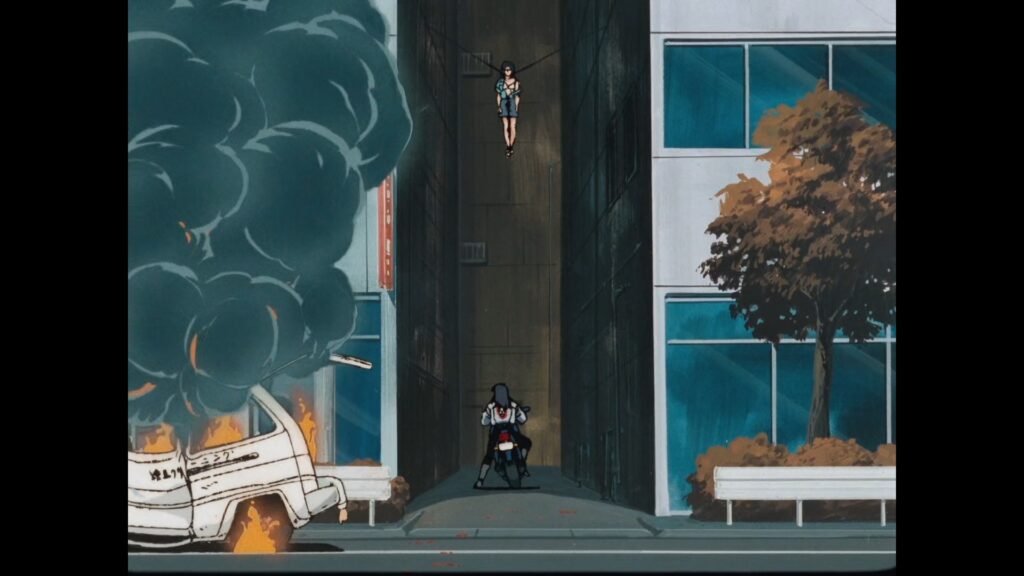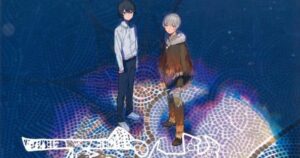Angel Cop – Episode 1

Hello folks, and welcome back to Wrong Every Time. Today we’re exploring another seedy artifact of anime’s indulgent OVA era, as we check out the first episode of Angel Cop. This six-episode series falls neatly in the popular bubble-era genre of cyber crime dramas, whose entrants range in tone from the lighthearted Bubblegum Crisis or Dominion Tank Police to more grim affairs like Wicked City or Cyber City Oedo, all offering some mixture of investigative theater, explosive action, and salacious interludes.
Angel Cop hasn’t exactly maintained a high profile over the years, but its principle creators have me extremely curious. The series is directed by Ichiro Itano, a legend of mecha animation history whose contributions to Space Runaway Ideon and Macross included the “Itano Circus” missile barrage, and who has otherwise acted as both director (his Megazone 23 segment is brutal) and mentor to a wide array of successors. He is here joined by writer Sho Aikawa, whose contributions to the original Fullmetal Alchemist and stewardship of the phenomenal, underappreciated Concrete Revolutio set him as one of the few anime writers I have absolute faith in. I’m quite interested to see how Aikawa’s restless political insight intersects with both the narrative tropes and cultural concerns of bubble-era action, so let’s not waste any more time rambling. Onward to Angel Cop!
Episode 1

Sirens wail in accompaniment to our bright red title, before we cut abruptly to a highway at night
Ah, traditionally animated cars – such a staple of these bubble era properties, and such a luxury nowadays. It feels like the advent of CG has more or less permanently hobbled anime in an aesthetic sense, in that now productions which would otherwise avoid including objects they couldn’t meaningfully animate will just create them in CG, thereby undercutting the visual holism and beauty of the whole. It’s similar to how CG has affected live-action cinema, in fact; I’ll pretty much always take a charmingly hand-made practical effect over a CG addition
Actually flexing here with the reflections on this roadside sedan, with the lights from the highway glimmering as cars pass by

The sedan hood pops, and four lovingly animated missiles fire out of a pocket missile bay beneath. I suppose it makes sense for an Itano production to open with some graceful missile trails
Excellent, voluminous explosions as the missiles strike what appears to be a US embassy
We then cut to a gorgeous overview of Tokyo in what appears to be the early morning, just as the sun’s encroaching presence begins to lighten the sky. The city is entirely composed of blues and blacks, with just a hint of pinkish glow in the clouds, alongside tiny specks of yellow glinting from various windows. A fantastic vision of a city on the verge of waking

A narrator informs us that at the end of the 20th century, Japan has become the world’s premier economic superpower. A common, understandable trend in bubble era media, an assumption that Japan’s economic expansion would only continue into the future. In the ‘91 Godzilla vs King Ghidorah, it’s proposed that Japanese economic domination would become so great it would demand time-travelers return from the future to stop the country’s rise
Time has an interesting way of contextualizing political narratives; I can easily see an Aikawa of the late ‘80s seriously mulling the consequences of an endlessly expanding Japan
Apparently Japan’s success has prompted foreign terrorists to attack the nation’s political and business leaders

Aikawa clearly reveling in the nitty-gritty of describing these counter-terrorism units. The bubble era was also likely the height of the anime as political thriller, as exemplified through the works of Mamoru Oshii
The terrorists are apparently communists, who are countered by an elite ten man squad with a license to kill. Aikawa’s still writing from the very tail end of the Cold War, and presumably also considering an emergent China in defining these variables. Hindsight is twenty-twenty, but it’s still funny to think this episode released in September ‘89, two months before the fall of the Berlin Wall would make its geopolitical concerns immediately dated
The important takeaway is our team is the Special Security Force

Ooh, love this man’s trench coat billowing in the wind as he boards this helicopter
Our character designer is Nobuteru Yuki, a legend whose other character design credits run from Escaflowne to Star Blazers 2199, and who you can always count on for ornate designs that draw on both realistic forms (largely for the men) and delicate fantasy (largely for the women). He’s got a perfect match on animation direction here, with none other than Yasuomi Umetsu of Kite/Mezzo Forte/etc fame handling those duties. A powerful alliance of artists that I imagine will facilitate an unusually realistic and tightly choreographed aesthetic
Really just showing off with these delicate hand movements as he lights a cigarette and takes a call from “Raiden.” I can definitely see the Umetsu in this; the male character in his contribution to Robot Carnival was drawn and animated quite similarly

The production manages its luxurious flourishes of character acting with an equal amount of stillness, like the minutes-long pan into that gorgeous vision of Tokyo. It’s an effective compromise
Raiden’s investigations reveal that the missile-bearing car was stolen from a pop star, and planted with clear knowledge of the cops’ tendency to overlook such vehicles
The terrorist group is known as the Red May
The variable prioritization of different cuts does lead to a somewhat disjointed aesthetic; Raiden’s discussion with this police officer varies between lip flaps alone and total fluidity

“Raiden” is Isamu Sakata, the first of our ten special operatives, who possess no official police rank
More detailed, extraordinarily realistic character acting as Isamu mounts his motorcycle. Interesting how trends change over the years; this isn’t the sort of scene a modern action anime would prioritize, it’s a focus on detail that seems more appropriate for quiet, observational drama. But modern action anime are all about digitally assisted spectacle, much like modern action cinema, while Angel Cop emerged into a world where “Stallone adjusting his jacket and shades” was the height of cool
We meet two more apparent special agents, with the distinction in character design between this muscle-bound man and petite girl demonstrating the exaggerated sexual dimorphism embodied by both Yuki and Umetsu’s character design sensibilities

The bombing was allegedly a distraction to facilitate the abduction of a man named Suyama, but apparently that doesn’t match Red May’s usual MO
Based on the employment histories of the kidnappers, it seems like they must have hatched this plan at least five years ago
The chief mentions “Hacker and Peace,” presumably the codenames for those two special agents
Some nice weighted combat choreography as Raiden takes down a terrorist cell. Quite similar to Umetsu’s usual style, though more grounded than his Hong Kong action-inspired theatrics

And then some gory grotesquery as our titular Angel is introduced, basically obliterating the skull of a woman sneaking up on Raiden. A clear demonstration of her brutality
“Just remember this – we’re not murderers!” “You think you’re so righteous, eh? You’re just bloodthirsty has-been cops.” The ‘80s were a banner decade for police brutality, with rises in urban crime inspiring such fascist counter-texts as Cobra, as well as a long string of Death Wish and Dirty Harry sequels. No surprise Aikawa has some thoughts
“Don’t you think Japan has been at peace for too long? Obsessing so much over internal affairs is a sign the country’s gone as far as it can. We want to save people from this rotting, stagnant country!” I wish I could say this is an unrealistic perspective, but ‘We must sow chaos to build a vital country where strength is valued’ is indeed the perspective of many lunatics, including much of the United States’ conservative coalition

There’s actually pretty clear parallels between these bubble-era concerns and our current societal collapse; given enough peace and prosperity, some portion of humanity will simply go insane, demanding violence for its own sake. I first saw this theory properly elucidated in Dostoevsky’s Notes from Underground, whose protagonist promised that whatever beautiful edifices humanity hoped to construct, his own antisocial bloc would surely destroy them. It’s not something I’ve been happy to live through
Red May’s leader Takeshi Suyama descends from the plane. They’ve given him quite the unflattering design, complete with a prominent overbite
He is accompanied by a Japanese man named Tachihara
A bomb disrupts the handoff, and the two escape in a helicopter

The chief apparently let them get away, as he suspects the official story here is faulty. Considering the Red May are supposed to be communists and those bombers were some kind of anarchic accelerationists, I’d assume so
“Just because he’s hiding behind left-wing radicals doesn’t mean he’s with the communists.” Yep
“You don’t have to be behind every little case.” It seems the chief’s own superior is complicit
“My men do not have the luxury of choosing their targets.” A quiet but deliberate dig, challenging his boss’s loyalty, emphasizing that while he plays political games, their agents are actually fighting and dying out there

“Taki, don’t be a loose cannon out there.” “Anyone who threatens the safety of our country is an enemy.” Easily translated as an outright threat – if this trail leads back to his boss, he won’t hesitate to pull the trigger
They find the helicopter with Suyama’s corpse inside, confirming that Red May was only a convenient vessel for Tachihara
The chief runs into a GSDF man named Ichihara, introduced with ominous electronic chords and dramatically saturated shading. With all that motivated framing, the fact that they gave him a withered vampire’s head seems hardly necessary

“I’ve heard of you. I won’t treat my men as guinea pigs.” While the military higher-ups play at wargames, the rank-and-file police suffer. A clear parallel between the peace-bought irritability and bloodthirst of these higher operatives and the values espoused by the terrorist earlier, presumably pointing to their shared goal of igniting the world and remilitarizing Japan. As Aikawa consistently demonstrated throughout Concrete Revolution, the history of post-war Japan is in many ways a battle between anti- and pro-militarization, a battle lent further urgency through the United States’ clear lack of dedication to a peaceful future, and their insistence on using Japan as a proxy in their forever wars
Extremely like Aikawa to promise a rip-roaring action spectacle, team up with action specialist Umetsu, and then offer twenty straight minutes of late Cold War geopolitical discussions
A discussion on what they’d do if a child was taken hostage illustrates the distance between Angel and Raiden, her pragmatic focus on the mission versus his sentimental prioritization of the people that mission is supposed to protect

A cleaning van full of terrorists takes off, and our team charges forward in pursuit
Ooh, terrific cuts as Angel shoots down the man riding shotgun, forcing an immediate stop that sends Raiden tumbling over the van. As per usual with Umetsu action, there’s an unusual, welcome sense of weight and consequence to these actions; you can feel both the van and Raiden respond to these collisions
Tachihara leaps from the van as it crosses a bridge, leaving his last collaborators to be hunted down by Angel
Even crueler, it seems he actually detonates a bomb in the van to prevent their capture
“Someone outside the SFF is killing terrorists!”

And Done
Whew, there’s a lot to chew on here! This OVA could easily just be a series of context-free action capers in the style of Umetsu’s usual fare, but with Sho Aikawa in attendance, we’re also getting an intriguing snapshot of Japanese political anxieties in the midst of its asset price bubble. In a rapidly changing world and astride a nation that has suddenly risen from post-war reconstruction to economic domination, the question of what future we are attempting to create is clearly on Aikawa’s mind, as the obvious factions of the Cold War give way to something more amorphous and intractable. I suspect things will get more fanciful as we proceed, but Aikawa always offers something worth chewing on, and Itano’s team are offering a generous visual spectacle to accompany his musings. Quite curious to see where we go from here!
This article was made possible by reader support. Thank you all for all that you do.








